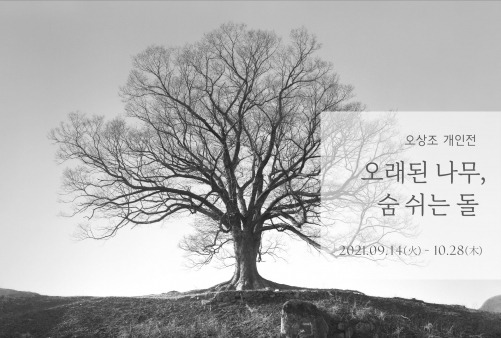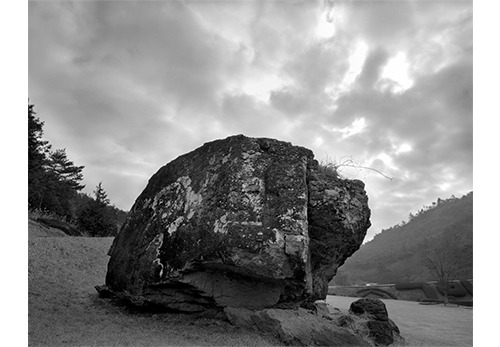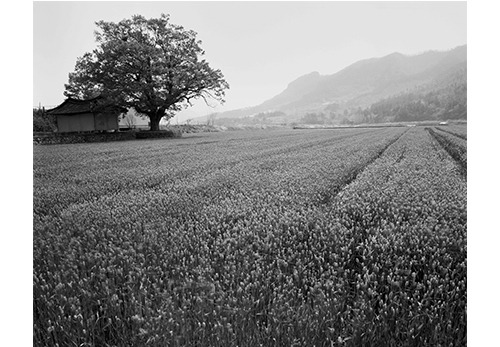
| Period| | 2021.09.14 - 2021.10.28 |
|---|---|
| Operating hours| | 10:00 - 18:00 Sat. 11:00 - 18:00 |
| Space| | Art Space J/Gyeonggi |
| Address| | 166, Jeongjail-ro, Bundang-gu, Seongnam-si, Gyeonggi-do, Republic of Korea |
| Closed| | Sun, Public Holiday |
| Price| | Free |
| Phone| | 031-712-7528 |
| Web site| | 홈페이지 바로가기 |
| Artist| |
|
정보수정요청



|
|
Exhibition Information




<Sangjo Oh Solo Exhibition _ Old Tree, Breathing Stone>_2021.09.14-10.28
"The Art of Artless" (Se-young Yoon), "Placidness, Calmness, Neatness, Peacefulness" (Dae-sik Kim), "A Honest Record" (Pyeong-jong Park), "A fervent search for the roots of Korean national sentiment" (Soon-tae Moon)
These are the expressions that criticize the works of photographer Sangjo Oh who has captured disappearing landscapes silently with analog cameras despite the rapidly changing trend of times for more than 40 years. Emphasizing that the essence of photography is ‘recordability’ that can show the phases of the times in the future, his works, which have recorded the landscape of his hometown, Namdo where the archetypes of Korean culture still remain, contain the author's long-standing contemplation and warm eyes on the nature which is the home ground of human life. So what is the story that the main subjects of his work, ‘Tree’ and ‘Stone,’ tell us?
‘Dangsan Tree’... A place of memory and communication.
Regardless of the East and West, there was a big tree at the entrance of the village. When the village site was formed, our ancestors planted ‘Dangsan tree’ at the entrance, center, or top of the village to pray for the well-being and prosperity of the village. In the past, Dangsan tree at the entrance of our village was a deified tree as well as the center of the physical and psychological community, and that is a symbol of the village. The Dangsan tree, which has been a part of human history for a long time, has lost its place in conjunction with the modernization process and is on the path of decline. Despite now being pushed to the outskirts without having an organic relationship with human life in the midst of such changes of time, the Dangsan tree proudly embraces us on the spot with its broad chest. By holding all the years passed with invisible roots under its outer surface, the Dangsan tree, which still looks majestic and magnificent at first glance, retains greater abundance inside than its apparent grandeur. Oh’s Dangsan tree reminds us of the moment when a man who returned home for a crime faces an oak tree at the entrance of the village waving a yellow ribbon as if the tree were welcoming him in the old pop song ‘Tie a Yellow Ribbon Round the Ole(old) Oak Tree.’ As a living witness and individual being who has watched numerous changes with strong and firm vitality, Sangjo Oh's Dangsan tree always welcomes us there and is positioned as a scene in one’s memories.
A world of observation embraced by a ‘Stone.’
The stone statues of Buddha and pagodas of Hwasun Unju Temple, which show the unprecedented formality and folksy humor of the rough with realistic and familiar appearances, dolmens scattered across the south of the Korean Peninsula, and both the ordinary stone bridge of rice paddies and the stone walls of a small old house, these are all the ‘stone figures’ that appear in Sangjo Oh's works. With the works of finding traces of stone, which is the most prototypically Korean landscape buried with the hands of our ancestors, Oh infuses the breath, thoughts, and philosophy of the old people merged in the stone to those living in contemporary era. Humans, who are undeniably finite beings, cannot go against the flow of time, so the low-pitched story of stone figures that still live and breathe over a long period of time gives us a gentle echo and emotion. Sangjo Oh's gaze, which digs deep into the essence of the object through long-standing views and consideration, reveals the various shapes and aspirations of our lives that have been living back a thousand years by approaching the nature of things.
Sangjo Oh's ‘tree,’ which contains unique Korean sentiments, and ‘stone,’ which creates a quiet sense of mystique, are warm. His trees and stones are living with people like that. "I stick to the gelatin silver printing method, which has been proven to be relatively conservative, and the large analog camera, because I want my photos to be left behind for a long time like the figures of trees and stones that have been by our side." Facing Oh’s works which are just like the artist, the expression of ‘Mokin Seoksim’ ¹comes to mind. Photographer Sangjo Oh has been slogging his way for more than 40 years with the firm belief of expressing the cultural traces of Korea through his photographs. Let’s look forward to seeing the Korean landscape that he will show us consistently in the future as ever, who has worked on photography all his life but still says, "I'm going to do it all my life, do I need to hurry?"
(Art Space J, Hye-won HAN)
* A person who is strong-willed or resolute like a tree and stone, so not swayed by any temptation.
